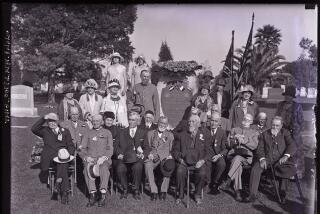Visiting Vicksburg, Miss., a city that was key to Northâs victory in Civil War
VICKSBURG, Miss. â The Siege of Vicksburg was all about the Mississippi River. Whoever controlled Vicksburg controlled the river, and whoever controlled the river was going to win the Civil War.
âVicksburg is the key,â said President Lincoln. âThis war can never be brought to a close until the key is in our pocket....â
Thereâs a reason Natchez, Miss., an hour and a half south of Vicksburg, has more stately antebellum mansions today than Vicksburg, which has a few lovelies of its own. When Union troops knocked at Natchezâs door in the spring of 1862, it practically laid down and rolled over. New Orleans? The same.
Vicksburg, a city on 300-foot bluffs overlooking the Mississippi River? No way.
Granted, the Union commanded all but the 250 miles of river from Vicksburg south to Port Hudson, La., just above Baton Rouge. But that 250 miles mattered. The Union needed the entire Mississippi River from southern Illinois to the Gulf of Mexico to freely move troops and supplies from north to south and east to west.
It was 150 years ago this week, after the 47-day siege of Vicksburg, that the Confederates surrendered. Maj. Gen. Ulysses S. Grantâs troops had nearly surrounded the city, and after several failed attacks, Grant decided to cut off all access to Vicksburg and outwait his enemies, depriving them of food and supplies.
Aided by a simultaneous Union victory at Gettysburg, Pa., the Civil War turned from Advantage South to Advantage North.
In late May, I drove 41/2 hours north from New Orleans to Vicksburg for the first time in years, having forgotten more Civil War history than I remembered. It was sunny and sweltering, as it was during the siege, when civilians living here suffered with soldiers.
After a bit, as we say in the South, I understood that at least a few Vicksburg residents still believe the phrase I heard die-hard Rebel descendants say when I was growing up: âForget? Hell no!â
Itâs more subtle now, of course.
On the second floor of the Old Court House Museum, an old-fashioned yet fascinating repository of photos, documents and more about Vicksburg, thereâs a sign over a door: âHonoring President and Mrs. Jefferson Davis.â Isnât the word âConfederateâ missing?
And when I asked a perky, 75-year-old guide whether she thought the South should have won, she answered, âAs a Southerner, I think the South should have won. But as an American, Iâm glad weâre one country.â
Then she smiled like a little girl with a secret.
And I learned one more thing about the Mississippi River. Although Grantâs troops couldnât divert it by digging canals, the river changed course naturally on April 26, 1876. It took the U.S. Army Corps of Engineers 25 years to force it back so Vicksburg could again be a riverside city.
These are the main facts. Read on for other surprising details and highlights of the Vicksburg Campaign:
A general with few fans. Confederate Lt. Gen. John Pemberton and his vastly outnumbered troops waited and waited during the siege for help from his superior officer, Gen. Joseph E. Johnston, who had amassed 25,000 soldiers north of Jackson, Miss., 45 miles east of Vicksburg.
Was he too much of a perfectionist?, as a park guide suggested. Or incompetent? Or chicken? Johnston was rarely aggressive in leading his troops into battle and had several disputes with Jefferson Davis, who gave him a lesser command than he wanted. Johnston wrote Davis that he thought it was âhopelessâ to try to save Vicksburg. He never came.
Soldier with a secret. Those who fought beside Union Pvt. Albert Cashier at Vicksburg thought he was OK, even if he didnât mingle much.
A soldier with the 95th Regiment from Illinois, Cashier was âbarely five-feet tall, thin and laconic.â He smoked a pipe and liked to sit alone, but he fought, and escaped when captured by the Confederates.
It wasnât until a doctor examined him after an accident in 1911 that anyone knew Cashier was a woman. The physician kept his secret; however, attendants in a mental hospital later outed her after a bath, and hospital officials forced her to wear womenâs clothes. When she died in 1915, she was buried in her Union uniform. In the 1980s, a second tombstone was erected in Illinois, with her male name and the one she was born with in Ireland, Jenny Hodgers.
Fierce and determined. Black troops fought for the Union for the first time in the Vicksburg Campaign.
Thousands of free men and former slaves had signed up with the Union Army, but many Northerners didnât want to associate with them and considered them incapable of fighting. They had to work as laborers.
Union troops were losing battles, however, and Lincoln wanted the black troops to prove they could fight. They did so May 27 at Port Hudson and June 7 at Millikenâs Bend, La. The Union lost both battles, but the black troops were fierce and determined, receiving praise from military and political leaders.
There reportedly were black enlisted men on the Confederate side, but they did not fight.
No July Fourth celebration. A threat of mutiny helped bring the siege to an end.
On June 28, Pemberton received a letter signed âMany soldiers.â It read, in part: âIf you canât feed us, you had better surrender us, horrible as the idea is....This army is now ripe for mutiny unless it can be fed.â The general polled his officers, who agreed it was time to surrender.
Pemberton and Grant met under an oak tree on July 3, but Pemberton refused Grantâs demand for an unconditional surrender. Their underlings continued to negotiate, and on July 4, Confederate soldiers laid down their arms and signed a pledge to return home. Each officer kept his horse and personal firearms. But July 4 â Independence Day â was not observed in Vicksburg until 1945. A volunteer at the Old Court House Museum told me, âYou donât celebrate defeat and pillage.â
Resting place for the Union. About 5,200 Confederates and 2,600 Yankees were killed or went missing in the Vicksburg Campaign, but almost 17,000 Union soldiers are buried in the 116-acre Vicksburg National Cemetery overlooking the Mississippi River, more than in any other national cemetery. About 40% are black soldiers. Only two Confederates joined them â by mistake. However, only 4,000 are identified with tombstones. The rest are buried under small, square stones, each with a number.
When Congress created the cemetery in 1866, it was specifically for soldiers who had fought for the United States. Bodies of Union troops who died elsewhere in the Southeast were moved there, and veterans of subsequent wars joined them later.
A separate place. Youâll find the Confederates at Cedar Hill Cemetery, but itâs not easy to find without a map.
A marker identifies a section as the Soldiersâ Rest C.S.A. (Confederate States of America) Cemetery and says it holds more than 1,600 Confederate graves. The National Park Service estimates that 5,000 were reinterred here after the Civil War, 1,600 unidentified. Some graves are near the entrance, but the majority are near a statue of a Confederate soldier. Confederate flags flew over the graves on my pre-Memorial Day visit; a local man said they were placed there because of a recent ceremony commemorating the 100th anniversary of the statue. He said Davisâ great-great grandson spoke at the event.
More to Read
Sign up for The Wild
Weâll help you find the best places to hike, bike and run, as well as the perfect silent spots for meditation and yoga.
You may occasionally receive promotional content from the Los Angeles Times.






